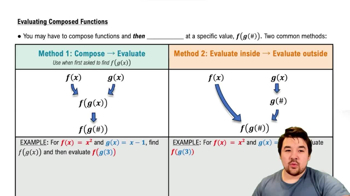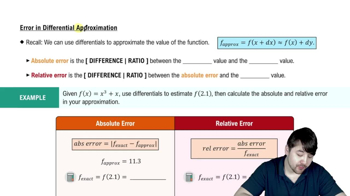Table of contents
- 0. Functions7h 52m
- Introduction to Functions16m
- Piecewise Functions10m
- Properties of Functions9m
- Common Functions1h 8m
- Transformations5m
- Combining Functions27m
- Exponent rules32m
- Exponential Functions28m
- Logarithmic Functions24m
- Properties of Logarithms34m
- Exponential & Logarithmic Equations35m
- Introduction to Trigonometric Functions38m
- Graphs of Trigonometric Functions44m
- Trigonometric Identities47m
- Inverse Trigonometric Functions48m
- 1. Limits and Continuity2h 2m
- 2. Intro to Derivatives1h 33m
- 3. Techniques of Differentiation3h 18m
- 4. Applications of Derivatives2h 38m
- 5. Graphical Applications of Derivatives6h 2m
- 6. Derivatives of Inverse, Exponential, & Logarithmic Functions2h 37m
- 7. Antiderivatives & Indefinite Integrals1h 26m
- 8. Definite Integrals4h 44m
- 9. Graphical Applications of Integrals2h 27m
- 10. Physics Applications of Integrals 2h 22m
4. Applications of Derivatives
Differentials
Problem 4.8.11
Textbook Question
{Use of Tech} Write the formula for Newton’s method and use the given initial approximation to compute the approximations x₁ and x₂.
f(x) = e⁻ˣ - x; x₀ = ln 2
 Verified step by step guidance
Verified step by step guidance1
Newton's method is an iterative technique for finding successively better approximations to the roots (or zeroes) of a real-valued function. The formula for Newton's method is: <math xmlns="http://www.w3.org/1998/Math/MathML"><mrow><msub><mi>x</mi><mrow><mi>n</mi><mo>+</mo><mn>1</mn></mrow></msub><mo>=</mo><msub><mi>x</mi><mi>n</mi></msub><mo>-</mo><mfrac><mrow><mi>f</mi><mo>(</mo><msub><mi>x</mi><mi>n</mi></msub><mo>)</mo></mrow><mrow><mi>f</mi><mo>'</mo><mo>(</mo><msub><mi>x</mi><mi>n</mi></msub><mo>)</mo></mrow></mfrac></mrow></math>.
First, compute the derivative of the function f(x) = e<sup>-x</sup> - x. The derivative, f'(x), is: <math xmlns="http://www.w3.org/1998/Math/MathML"><mrow><mo>-</mo><msup><mi>e</mi><mo>-</mo><mi>x</mi></msup><mo>-</mo><mn>1</mn></mrow></math>.
Using the initial approximation x₀ = ln(2), substitute x₀ into the Newton's method formula to find x₁: <math xmlns="http://www.w3.org/1998/Math/MathML"><mrow><msub><mi>x</mi><mn>1</mn></msub><mo>=</mo><mi>ln</mi><mo>(</mo><mn>2</mn><mo>)</mo><mo>-</mo><mfrac><mrow><mi>f</mi><mo>(</mo><mi>ln</mi><mo>(</mo><mn>2</mn><mo>)</mo><mo>)</mo></mrow><mrow><mi>f</mi><mo>'</mo><mo>(</mo><mi>ln</mi><mo>(</mo><mn>2</mn><mo>)</mo><mo>)</mo></mrow></mfrac></mrow></math>.
Calculate f(ln(2)) and f'(ln(2)) using the expressions for f(x) and f'(x). Substitute these values into the formula to compute x₁.
Repeat the process using x₁ to find x₂: <math xmlns="http://www.w3.org/1998/Math/MathML"><mrow><msub><mi>x</mi><mn>2</mn></msub><mo>=</mo><msub><mi>x</mi><mn>1</mn></msub><mo>-</mo><mfrac><mrow><mi>f</mi><mo>(</mo><msub><mi>x</mi><mn>1</mn></msub><mo>)</mo></mrow><mrow><mi>f</mi><mo>'</mo><mo>(</mo><msub><mi>x</mi><mn>1</mn></msub><mo>)</mo></mrow></mfrac></mrow></math>. Calculate f(x₁) and f'(x₁), then substitute these values to find x₂.
 Verified video answer for a similar problem:
Verified video answer for a similar problem:This video solution was recommended by our tutors as helpful for the problem above
Video duration:
6mPlay a video:
Was this helpful?
Key Concepts
Here are the essential concepts you must grasp in order to answer the question correctly.
Newton's Method
Newton's Method is an iterative numerical technique used to find approximate solutions to equations of the form f(x) = 0. The method uses the derivative of the function to refine guesses, starting from an initial approximation. The formula for the method is x₁ = x₀ - f(x₀)/f'(x₀), where x₀ is the current approximation, and f'(x₀) is the derivative evaluated at x₀.
Recommended video:

Evaluating Composed Functions
Derivative
The derivative of a function measures how the function's output changes as its input changes. It is a fundamental concept in calculus that provides the slope of the tangent line to the function at any given point. In the context of Newton's Method, the derivative is crucial for determining the direction and magnitude of the adjustment to the current approximation.
Recommended video:

Derivatives
Initial Approximation
The initial approximation is the starting value used in iterative methods like Newton's Method. A good initial approximation can significantly affect the convergence speed and accuracy of the method. In this case, x₀ = ln(2) serves as the starting point for calculating subsequent approximations x₁ and x₂, which will help in finding the root of the function f(x).
Recommended video:

Initial Value Problems







